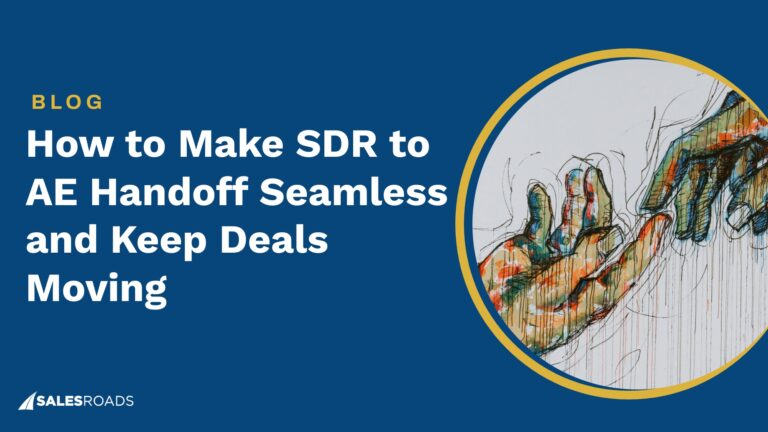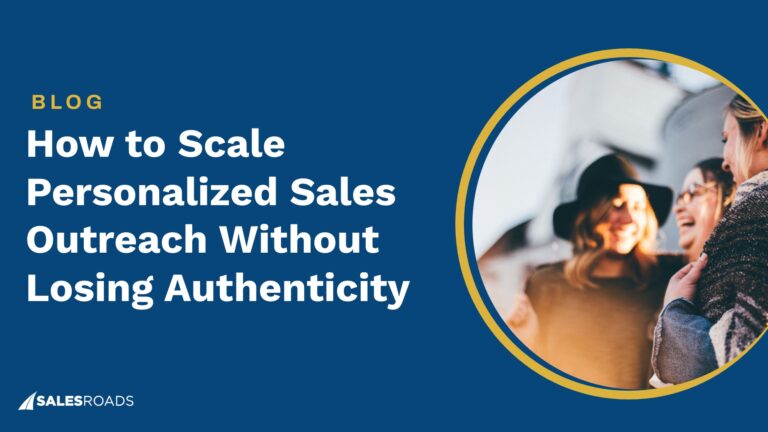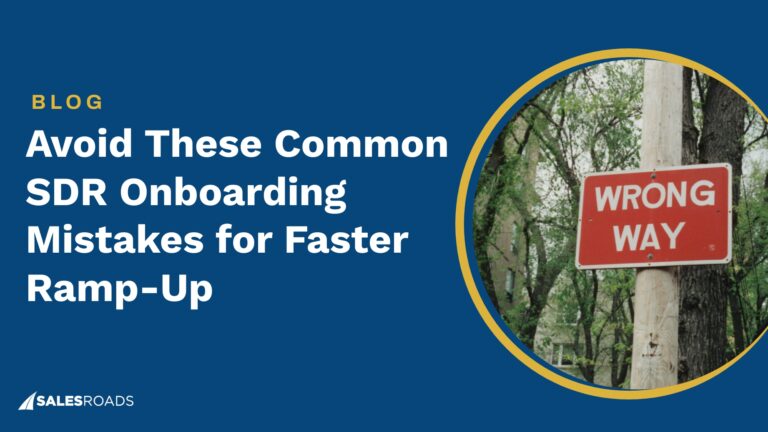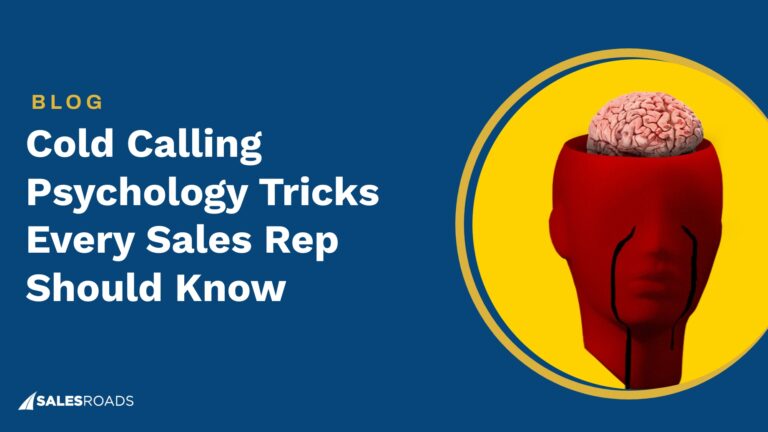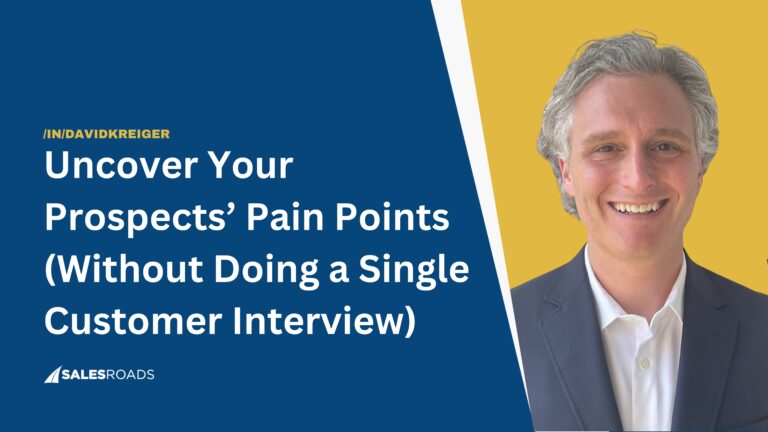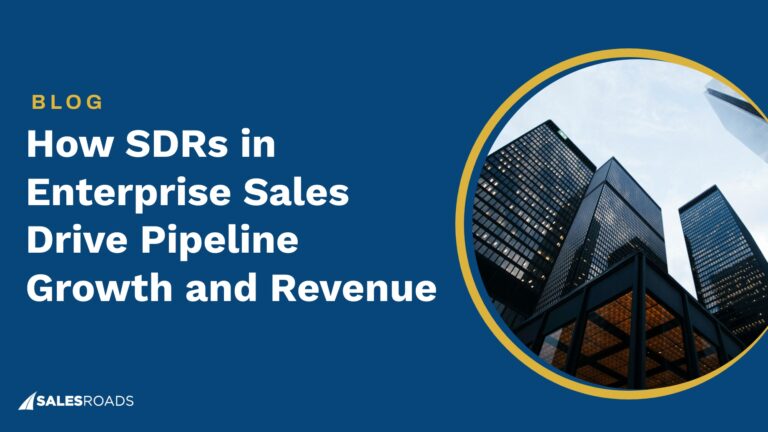Sell Like A Leader – Episode 28
In this episode, we dive into:
– AI agents and human SDRs: Sales integration, blending human and AI, market testing with AI, pipeline efficiency, guardrails and safety in AI, SDR role evolution, AI-driven outreach, cross-customer learnings, autonomous and copilot modes, and the future of sales teams.
– Rapid fire Q&A
About Frank Sondors
David Kreiger chats with Frank Sondors, the co-founder and CEO of Salesforge. He helps B2B companies generate more sales pipeline and reduce costs by blending humans and AI agents. He scaled to $3M ARR in 12 months and is looking to get to $10M ARR next.
Podcast Key Takeaways
- Frank discusses how AI can support sales reps by handling tasks such as lead research, email crafting, and managing responses. He believes AI can outperform average reps by offering faster and cheaper results, though it may not yet surpass top performers.
- Sales leaders can start with “copilot mode,” where AI assists but human intervention remains central, before fully transitioning to autonomous modes as confidence grows.
- To ensure AI actions align with brand standards, setting up guardrails is crucial.
- With the increasing use of AI, Frank foresees the role of SDRs evolving towards more technical and strategic functions, describing a future with more dev-focused roles like “GTM engineer.”
Connects
Connect with Frank Sondors: https://www.linkedin.com/in/franksondors/
Connect with David Kreiger: https://www.linkedin.com/in/davidkreiger
Subscribe to the podcast and follow our Podcast LinkedIn page so you don’t miss any episodes!
Transcript
David: Welcome back to another episode of the Sell Like a Leader podcast. The podcast for revenue leaders who are on a mission to cultivate high-performing sales teams.
I'm your host, David Kreiger, president of SalesRoads, America's leading sales outsourcing, appointment setting, and lead generation company, and I am bringing you today an amazing revenue leader, Frank Sondors.
Frank comes with over a decade of experience in B2B sales as a top contributor all the way to leading large sales teams, and currently he's building Salesforge and other forges, which we'll talk about what that means, to help B2B companies generate more sales pipeline and reduce the cost of blending humans and AI agents, which is a hot topic right now.
And they are on an explosive growth trajectory with 3 million in ARR in just the [ 00:01:00 ] first 12 months and looking to get to 10 million ARR in the next 12 months. So let's get started. Welcome to the show, Frank.
Frank: Thanks for having me. Yeah, it's good to be here. Yeah. I've spent over a decade in sales. And then probably by the end of it, when I was leading a sales team of about 50, I was too comfortable, I think, selling a software of somebody else, and I thought to myself, why couldn't I just sell a software, keeping all the equity to myself, in a way, right?
But I did, I did get two co-founders, 'cause I can't code, typically most salespeople cannot code. So I got two smart cookies through YC matchmaking platform. Essentially it's like Tinder for startup founders. I found two really cool guys, what I call the 10x Silicon Valley Engineers. That I found in Europe, and then I started and kicked kicked things off. Um, But yeah, I spent the, you know, as I said, decade in sales, started my career in Big corp. So that's Google. This is where I got my digital academy training and all things digital ad tech, MarTech, you name it.
So all the cool proceeds, how things can be automated to the fullest. And that's really, that's something that you can really see in Google really well. And then I transitioned [ 00:02:00 ] to work for a bunch of SaaS companies. This is where I fell in love with SaaS tech, sales, in SaaS in particular.
And I stayed in SaaS for the whole of my, my, my lifetime really. And probably gonna be always in SaaS, unless I'm gonna become, I'm gonna, unless I'm gonna exit with essentially Salesforce. And I become a, essentially a VC, probably already have a name for it called Baking Capital. So in our business line of business, it's all about bacon, bringing home the bacon and stuff like that. So yeah. And yeah.
Really the reason why I start, decided to also start my own thing is because I saw that when I had the sales team of 50, and back then it was a growth at all costs, right? So I was ultimately the main lever to, to target attainment was just having more bodies, right?
And I didn't think that was the right way to, to looking at things, acquiring more revenue, et cetera. But it was really the main way because all the tech essentially that was in the space, it was orchestrated around having more heads, right? So more heads means more revenue, more pipeline. And I thought to myself, wait a minute, I hired hundreds of people in my life and I fired hundreds of people in my life in sales.
And I always had this sort of, there's always [ 00:03:00 ] this sort of typical math that for every 10 salespeople, only one person is really the natural. Two to three people can be trained up to be somewhat good as the person that's natural. And then 60% is what I call dead wood. And if you have those numbers in mind, and why are we hiring the 60% in sales, right?
If they're not additive to your organization, and that's because you have a, you target to hit. So all these extra bodies that they do help you to hit that target. But we all know that typically the top 20 or the top 40% of the sales population driving the majority of the pipe, the majority of the revenue in your organization.
And I thought to myself, what if we could increase somehow the output of the 40% and get rid of the 60%, and that's exactly what we're up to here at Salesforge. We are trying to make companies leaner and meaner, help them to attain their target with the least headcount possible, and doing so what we call with the highest probability using big data behind the scenes. So yeah, that's what we're up to.
David: Yeah. The way that you're doing is really, it sounds like the idea of co-pilot mode, right? Where you're trying to blend AI agents [ 00:04:00 ] and human SDRs so that they can work together seamlessly. And I think a, there's been a lot of AI tools thrown at us over the past year and a half with AI and I think lots of sales leaders are trying to figure out how do I incorporate this, and trying to find good use cases for it.
And I think there are maybe a million, but it's hard to curate that and figure that out. So maybe just starting with the big picture, how do you look at a well-functioning collaboration between human and let's talk about SDRs. 'Cause that's, I think the focus, right? And AI agents look like in practice.
Frank: Good question. There's a lot of tech and what I call a lot of legacy tech and big tech essentially in the space which essentially is all catering for humans only. And then there's a lot of cool, fancy new tech popping up, which essentially they're saying, Hey, we're building these AI agents to replace humans in full.
But then you as a sales leader, you're faced with your current tech that you have, which is, designed for humans. And then there's a bunch of extra tech for AI agents. Now, if you're really smart or, and I wish [ 00:05:00 ] everybody would be smart, but if you're really smart, you're gonna be thinking typically like, Hey, I really want these two things to coexist in one place. And the best way to look at this is I typically bring up sort of Google ads.
So if you, somebody's swimming with Google Ads and how you typically run campaigns in there, you typically have these sort of. Campaigns, what's called a manual bidding. Bidding. So these are essentially human campaigns.
And then there's campaigns that popped up a few years ago called automated campaigns where you just set up the target CPA. So what's the cost per acquisition that we're looking to, how much we're looking to pay essentially per lead.
And then Google will optimize the bids according to the target CPA. That's exactly how we are thinking about the world of what we call humans. SDRs plus AI, SDRs, it all has to coexist in one piece of software. So it's very easy for an SDR manager or a sales ops manager or a VP sales to, to go into the software, run their sales team across email, LinkedIn, VoIP, and then also and additionally to be spinning up these AI SDRs.
And an example of that, so let's say you are a big org, right? So let's say you have, again, 50 salespeople just like I had. So the 50 salespeople [ 00:06:00 ] typically will go after key accounts because according to unit economics, it makes sense that we all focus on these key accounts in these particular territories like US, et cetera. But then we have ROW, right? Outside of the US, right? That may, we maybe want to go after a few accounts in France or Germany, et cetera, but we don't really speak the lingo. Right?
What if we can spin up an agent where we can test the market, for example, let's say the French market or the German market. And that's exactly where you could, for example, leverage the AI SDR for let's say, just testing purposes, right? So to understand whether there's any traction. What is it that you're selling outside of US, right?
And that's something you don't have to hire the rep that speaks the lingo, right? You can spin up an AI agent that actually can do that for you. What does that actually mean in practical terms? In practical terms in what an AI SDR can do really well in the world of, say, email or LinkedIn.
There are some issues with work, meaning calling, there's some regulatory issues. But let's say in the world of, if you take just like email as an example, you would set up your ICP. Within the software. So what's the ideal customer profile? Then we would source the leads. It's called Agent Frank.
So Agent Frank would source the leads for you across multiple databases in the [ 00:07:00 ] world. And then we would craft a unique and relevant email to each and one of those recipients in the language of your choice so that the uniqueness comes from two data sets.
So what we call the sell data or what the heck do you sell, or why the heck you're reaching out to people. And then we combine that data set with what we call the biodata, what is it that we know about each and every single recipient? So we go and access the LinkedIn, we go and access the website.
We go and access a bunch of other sources. So we match these two data sets. We use LLMs on top of that, and then off we go. We deliver that unique email and there's a couple follow-up emails that are uniquely crafted as well for that. Recipient.
Now, if the recipient replies back, then we use a, essentially what we call a knowledge base, where you can upload a bunch of information about your business, like a sales playbook, et cetera, where if the prospect replies back, essentially we can have a conversation back and forth. All the way down to actually booking a meeting, fully autonomous on autopilot.
And the way that we book meetings is you just hook up your HubSpot calendar link, maybe your Calendly link or Google Calendar link, right? You hook up to the engine and then the agent is responsible for [ 00:08:00 ] actually booking meetings. So while I'm talking to you, agent Frank, currently books meetings for me. So now it works in a lot of cases, but in some it doesn't.
You also need to have what's called naturally. Product channel fit. So, apart, apart from having PMF, with your product, which is a prerequisite for anything typically to work, you also had need to have a product channel fit. So, uh, naturally if you have never tested let's say in any form of cold emailing, reaching out to people at a particular velocity, don't expect that the some form of agenda capability may be able, will actually to do that much, much better, to an extent, essentially, where it actually works for you.
So, um, I always ask, and try and, talk to businesses and sales leaders, Hey, are you actually sending currently any form of cold emails? And then a lot of people say, no, it has never worked for us. Or, and then what makes you believe that this actually thing will work for you? Right?
So even though the agent will do. Uh, great, great job, got relevant emails, everything will be super, super nice. What makes you believe actually that it'll actually work? Yeah, so there's a lot of tech yet that's in space. It's quite a, heated, especially on LinkedIn, right?
So a lot of people will say, yeah, [ 00:09:00 ] AI SDRs don't work because they, all the emails are just junk, et cetera. But that's, you have to also think about it, that this whole tech. It's in its infancy. It only exists for a year or so. That means all the players in the market haven't been even around for two years.
So we haven't even been around for two years. And there's essentially a lot of room for this to improve, right? To orchestrate the right experience, right the right way of using the AI agents. Um. And that is yet to come. And I think this year is the year where we're gonna see a lot of fantastic agentic workflows that a lot of sales leaders, will be utilizing essentially, all right, to drive more pipeline coverage at lower cost per unit. So yeah.
David: Yeah. So as you're trying to think, or sales leaders are trying to think what is a good workflow for AI. Basically, I think if I'm understanding what you're saying is first you need to validate it with humans and make sure it's been working or it's a channel that's worked with your prospects.
Because if you haven't necessarily been able to validate it, you're not necessarily gonna be able to validate, at least where we [ 00:10:00 ] are with the tech right now with AI. So validate first and make sure it's a channel that works, and then go in and try to leverage your learnings to be able to leverage AI to do this autonomously without human intervention.
Am I capturing that correctly, Frank?
Frank: An AI agent is not there to get you that product-channel-fit. What an AI agent does, it just does things faster, cheaper, and slightly better than the human, right? But an AI agent, I don't believe an agent will be ever able to outperform the top rep in your organization, but it'll outperform all the averages, essentially the Bs and Cs that you have in your org.
That's what the AI agent is really good for, but yeah. Yeah, essentially, if you haven't never done this in the past, and a lot of companies, whether, you just spun up your a startup from the YC or whatever, you have never done anything like this.
So don't assume that there will, there is a product-channel-fit by default.
David: Okay. The types of tasks right now, at least, and maybe you can [ 00:11:00 ] talk about right now and maybe in the future, and maybe you can elaborate on some of the regulatory challenges with voice and things like that.
It sounds like really doing the lead research and trying to leverage AI to really analyze, and we've seen that in sales reps a lot. It's really been very good at analyzing lead lists, being able to do some of the web research that SDRs had to do in the past, looking at websites, looking at LinkedIn and then.
Creating some of those workflows that are more written in communication on LinkedIn and email. Is that right or are there other workflows that you really think are right for AI to help as a co-pilot?
Frank: Yeah. So it's, yeah, definitely qualifying the list, the leads before you would engage. So you don't send emails to the wrong people, or non-ICPs essentially. So qualification, yeah, all the way down to. Yeah, sourcing the right leads. Then all the way down to crafting the messaging all the way. Then we're going over to handling replies. It's a huge process, right?
Making sure that you are responding literally within minutes back to the prospect [ 00:12:00 ] because time, kills deals, kills opportunities, et cetera. I see a lot of reps that don't respond within two hours.
When once you got a reply back, essentially if if you respond later than that, then the probability of getting that individual on the call drastically reduces. And then actually book a meeting and following the process, right? Day in and and out.
But yeah, now, right now a lot of AI capabilities are definitely popping up also in the world of LinkedIn. You may have observed that. And then also right now they're also coming into voice. Though there, there are some regulatory restrictions where using any form of agenda capabilities on outbound meaning doing literally a cold call is not legal under the robo-calling directive.
That may change. But essentially there is a directive where you can't use any form of sort of automation to be calling people out of the blue in the world of B2B and B2C. But you can do that actually with humans, right in the world of B2B. But we are seeing fantastic agent capabilities on inbound, right?
So once you get the opt-in from the user, I highly advise for you to explore a bunch of solutions that are in the market right now. For the voice staff because ultimately you can set up an agent to be calling literally within the two minute [ 00:13:00 ] SLA and the inbound is super important.
'Cause only three things really matter on inbound. One is the leads, process and then the speed. And most of the sales leaders really forget about the speed component, which drives pipeline and conversion rate. And if you're struggling, to make sure that your reps are calling your leads on time with a, within a particular SLA, then voice agents are fantastic, right? And much, much cheaper as well.
David: That's great. As sales leaders try to implement AI, is there any type of reporting that is unique to AI? Are you using the same type of metrics you would use to manage a human as you would in AI?
Frank: I would say the metrics are exactly the same. So the only thing that the. Head of sales or the CRO are asking themselves behind behind the scenes, how much is this costing me and how much is that costing me? So you could calculate what's this costing me like per demo, right? So you can calculate, okay, I have this human headcount and the cost per demo is, let's say 500 bucks. And then you can do the same calculation for the agent stuff. And you can be like, okay, how much is this costing me?
And then you [ 00:14:00 ] can realize whether this is much, superior, CAC metrics for you or not. But that's not something that you would look at within the software. So within the software, exactly. Exactly the same metrics. What are the reply rates, how many meetings are we booking, et cetera. Whether this is in the agent or human, right, and this is the benchmarking that you can do, right?
And you would expect naturally in a bunch of cases that humans outperforming and in some cases say, yeah, agents outperform if you're running a bake-off, right between the two capabilities.
But my belief is that you should be having these two things running in tandem, right? You just need to figure out what's the workflow there. But because ultimately by using both, you are unlocking more pipe. At lower cost, right? So that, that's why I'm a big believer. It's not either one or the other thing that you should be using, you should be using both at all times. Doesn't matter whether you are, a day zero founder all the way up to Fortune 500. I think there's always a space for an AI agent within pipeline building workflow.
David: That makes a lot of sense. And I think some leaders hesitate to implement AI on some of the forward-facing interactions. 'Cause they worry that they might [ 00:15:00 ] lose some of that personal touch, that relationship. They might come off as sounding like AI.
How do leaders strike that right balance between automation and real human engagement?
Frank: So there is a way to set up, let's say now case, right? So if you are not comfortable with AI, right? So you wanna get used to it, we have what we call the, not the autopilot mode, but the co-pilot mode. So essentially where the human intervenes a lot more. For example, in the co-pilot mode, when you do get a response back from your prospect any form of reply, the AI agent will stop and you will jump in as a human, right?
So you'll get a ping, let's say in Slack or as an email. You're gonna get it a ping. And then the agent stops. And then you take over, right? So that's the co-pilot mode. And the autopilot mode means that you, the human does not really intervene unless the agent doesn't doesn't know what to do.
So typically, most companies, not all, but most companies, what they will do is they will set up these, what's called guardrails, right? Making sure that the agent cannot say something that may, that [ 00:16:00 ] is not in line with what is that we're selling, for example, right?
And that's technically speaking is called gatekeeping. So essentially you gate-keep, for example, content. So when we are about to send an email out, for example, to another human, we scan that piece of email. And if there's any form of hallucination. So we use AI, another AI agent to check that email, and then if there's any form of hallucination within that email, then we will compute it again until it'll pass the quality checks.
So some agent capabilities may not do that, but these sort of guardrails are super important to make sure that we don't send random content now, right? To prospects, right? To making sure that we're protecting your brand, right?
And also the same thing actually happens when we're about to reply back to the prospect. For example, what the agent does it, let's say, the prospect ask, how are you different to this competitor? What is your pricing, for example? So the number, the agent does it, it checks all the available documentation about this business that's available within the software. That the human uploads and will only reply based on what's in available.
And if we get a question from a prospect [ 00:17:00 ] where we don't know the answer, the agent essentially will stop. So there's an evaluation that we are doing essentially on the reply as well, where we're checking, okay, is this a good reply? Is this a bad reply? And if the confidence drops below. X threshold, then the agent stops and informs a human saying, I don't know what to do in this particular case. Here's a draft reply. Please adjust that reply before we send out.
So there's a lot of these things that you are essentially, where you're trying to make the I'll actually use this, more comfortable with AI. But I would say it's like the internet moment where people are just getting used to using these AI agents, because 99% of companies still today have not used an AI agent.
And I think this year will be the massive AI agent wave where the adoption rate will massively increased from 1% over to, God knows 10% or whatever. Uh, Is my take. Because, you know, a lot of people have the appetite, but yet there's still, you know, because there's all these companies that are building these AI agents for different functions of the business, whether that's sales, finance, et cetera.
Because we all live in a capital society. We all want to be generating more revenue with the lowest [ 00:18:00 ] possible headcount, right? And AI agents is exactly the thing that can unlock the that, that wish, of the society that we live in.
David: And, to achieve that. I think sales leaders are very familiar with onboarding, training of their sales team, and AI agents, right? Need something similar, right? Training refinement like you said, have that, that, human guardrails, just like you would have manager guardrails in some ways.
So how do you look at effective AI training and optimization?
Frank: Good question. We do a couple things main ones that make a big impact. First one is looking at so we are sending these unique emails to, to our prospects.
Let's say the AI agent does that, and then we're looking at what sort of response are we getting back? Getting positive responses or negative responses. And essentially this is where we have the mechanism in place where we're essentially saying job well done to the AI, right? When we get a positive reply, when we get some sort of good reply.
But if we get a lot of bad replies saying this was a horrible email, et cetera, then essentially the AI learns from that. I'm trying to put this, as simple as possible, right? [ 00:19:00 ] So essentially we're looking at, you know what, the prospects respond back to us and that goes into the engine essentially.
And that's something that we use to optimize the messaging further. So if we are getting a lot of positive responses based on this sort of messaging or this sort of style, then a lot of messages start essentially change for the next batch of emails that will go out, let's say the next day.
Would the style of the sort, the style of the emails would change towards the type of emails where we get more sort of positive replies. So that's one way of doing this. The other way that we do it, we look at also. What so we have a lot of, we have thousands of customers already by now, and what we're looking at within behind the scenes is.
And okay, we have a, let's say a lot of customers from the same industry, let's say FinTech as an example, right? And then they sending the emails to the same ICP. So we are also checking across all the customers, what sort of messaging works and what doesn't, right?
So we have what we call cross-customer learnings that we apply behind the scenes. So it's similar thing that Google does, right? They do apply learnings across thousands of its or millions of its customers, right? And we show those learnings essentially in a compliant manner.
And that's exactly what we [ 00:20:00 ] do, right? We're trying to figure out what are not at, when we run millions of emails, we literally send millions of emails a day, right? So we have a lot of data that goes through and then we store that data, we log that data, right? We label that data and we do cool stuff. Cool stuff, meaning we're trying to improve the conversion rates for our customers using all of that data that we have access to.
David: Okay. Interesting. And so, you know, looking forward, as AI gets better as we coach it better as it gets better within organizations. We're in co-pilot mode right now and there are some autonomous things, but as it does get better and as sales leaders become more comfortable leveraging AI, how do you see the traditional SDR role?
And are there certain skills that humans really need to focus on that are uniquely human, that an AI won't be able to replicate? Or do you feel like over [ 00:21:00 ] time that this is really moving more and more towards an AI world?
Frank: So we are moving towards an AI world, whether somebody likes it or not, right? So you can embrace it or not. And I believe people that are better off are the ones that are gonna be embracing AI.
So that means, what does that mean? So when you go into a job interview and you are interviewing somebody for an SDR role, as an example, you would typically, and if they've done a bunch of SDR roles, you would typically ask one of the questions, Hey, what sort of AI tools have you used? And if the rep says, I've, you used none of the tools. Then it's a red flag. And so immediately, like I would not hire the rep because you're trying to get your job done, you're trying to book meetings, right?
And you should be using simple tools like ChatGPT to get your job done. And if you're not using even all the simplest tools in the market, then I don't think that the, I don't really think that the rep will be able to get to the pipeline of targets as effectively as another rep. Uses AI agents, right?
So it's super important from perspective of kind, hiring standpoint to be using these agents and these tools, right? Because ultimately the [ 00:22:00 ] output levels of rep that uses AI agents, et cetera, should be. And typically is higher than those reps that don't use anything. And what I'm seeing, the type of skill set that we definitely all will be looking for in the future, we're gonna see a lot of these reps they're gonna be becoming more senior.
Essentially what I'm trying to mean is there's this sort of, thing that's that's trending right now also on LinkedIn and also all around the world, which is what's called a GTM engineer. I call it a sales development engineer, essentially SDRs, that are able to do thing technical stuff, right?
That a typically a sales manager would do because, for example, they're looking to stitch, tool one, tool two to get, build a list, et cetera. So we're gonna, we are gonna see in the future a lot more SDRs that are technical. Than just, a lot of kind of juniors essentially that's coming out of college, right?
And that's something that I'm definitely observing and naturally these people who are a lot more senior also get paid a ton more as well. But then the contribution to the organization from a sales pipeline standpoint is humongous. So essentially one of these individuals can [ 00:23:00 ] replace typically up to 10 SDRs.
So this is what we're gonna see more senior folks in the SDR function. That are able to do the work of multiple SDRs using a bunch of cool, new tech in the space. So it's not just our tech. There's a lot of other tech and all of that tech is designed towards generating more higher output levels, essentially with very little headcount.
David: Very interesting. Frank, that's a fascinating perspective. It's gonna be interesting the next few years to see how. How companies like yourself really impact efficiency among in, in go-to-market and how SDRs can become that much more productive.
Before we go though, I would love to ask you a few rapid-fire questions that we ask all of our guests. Does that sound okay?
Frank: Sounds good.
David: Awesome. So what is one thing people don't give enough value or attention to in leadership?
Frank: Listening to their employees, I would say. And like really listening, because [ 00:24:00 ] naturally there's a bunch of employees that are in the frontline, whether that's your customer success managers, your account execs, et cetera, right? Because they're they're in the trenches, right?
They're speaking to the, to, to your prospects, your customers, on a daily basis, right? And like really listening to your account execs and customer success managers is super, super important. And so yeah, that's the number one thing. Listening more to your employees that are in the frontline talking to your customers on a daily basis. Yeah, that would be the top thing.
David: Awesome. That's great. What's one skill you advise everyone in sales to master?
Frank: It is very similar to the first one, listening more to your customers and not just listening and saying, Uh-huh. Okay. So you really wanna figure out what, what the reasons why people buy your stuff and the reasons why people don't buy your stuff. And you wanna go to the rest of the organization and feed the organization, right?
And you can only do that if you're really listening to customers. And trying to jot down these super important reasons why they're buying our stuff, why they decide to go ahead and why they don't wanna buy our stuff, right? So we can optimize the whole [ 00:25:00 ] process. Super important. So yeah, listening to your customers a lot more. And you'll be surprised the number of sales leaders and also founders that I'm speaking to on a daily basis that don't speak enough.
So even, myself, I'm a CEO of a company and I have a huge, a huge team, but even I manage to speak to, and I literally jump on at least 10 calls on a weekly basis with customers. Listening to them practically and then proactively essentially asking questions and then trying to feed our system and feedback to improve the product, to improve the service, et cetera.
David: That's awesome. What's your favorite business leadership or sales book?
Frank: I would say one of the favorite books is Never Split the Difference. Or the other one is Tech-Powered Sales by Justin Michael. These will be a couple that I typically recommend.
But there's a bunch of sales leaders that I do follow on LinkedIn because I'm a founder right now, I do follow quite heavily Jason Lemkin that runs the SaaStr events out of the Bay Area. And he gives, on a pretty much daily basis, tidbits on what to do, what not to do as a founder. And most of them, actually, many of them apply definitely to sales, fundraising [ 00:26:00 ] and stuff like that.
So if you're ever thinking of running your own company, he's definitely one of the best people to follow. But otherwise, there's a bunch of other really cool sales leaders slash influence, whether you wanna call them, whether they do share a lot of knowledge free of charge on LinkedIn.
David: That's awesome. Favorite quote, mantra, or saying that inspires you as.
Frank: I would say watch your CAC is the main quote. So what you can see on the macro level is that. Acquiring net new deals is becoming a lot more expensive and a lot of sales leaders don't watch their CAC. And you'll be surprised, essentially just they're just burning through tons of tons and tons of money.
But they actually are not acquiring very effectively their customers. And really the smartest leaders that I know, they always watch their CAC very carefully. CAC payback period and stuff like that. But I always say, watch your CAC. And I think that's my favorite quote.
David: That's awesome. And then finally, what's your most important goal or project that you're working on right now, Frank?
Frank: So the most important goal this year is to hit the 10 million bucks in ARR as a [ 00:27:00 ] milestone really. So it's following again, Jason Lemkin and a bunch of, a lot of people that would say triple double where another triple that we have to do this year.
And that's that's what we're up to. And that's really the main milestone of the business. We're optimizing everything in the business, from product engineering to sales, marketing, et cetera, to hit that 10 million.
David: That's awesome. I would love to watch your growth, Frank. It is a fascinating company. It's a fascinating time. Loved your perspective here. Appreciate you sharing that with all the sales leaders out there.
And, if they wanna learn more about Salesforge, uh, connect with you, Frank, how do they check you out?
Frank: Probably LinkedIn is the best spot. So Frank Sondors, the guy with the bacon emoji. So if somebody doesn't know what Bacon means, go to ChatGPT. And do ask yourself here, what does bacon mean in sales? It'll be a little homework for some people that are listening in.
You'll be still surprised the amount of people that don't know what Bacon stands for. So that's definitely one num number one place. Then yeah, if you wanna check out the site at Salesforge.ai, but otherwise you can also find me at @franksondors.
David: Awesome, Frank. Well, this was great. I love the conversation. It's really fascinating to see what's happening in our space and how we can [ 00:28:00 ] maneuver and become more effective.
And listeners, thanks so much for joining us. I hope you enjoyed the conversation as much as I did. You can always reach out to me too, with any questions, guests you want to have on the program. I'm active on LinkedIn, but until next time, thanks so much.


